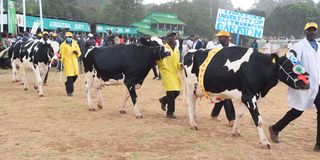Understanding the timing of artificial insemination in cows

Dairy cows during the ASK National Fair in Eldoret on March 3, 2023. Veterinary experts have heavily researched cattle reproduction and given the best timing for AI.
When listening to farmers, I get interesting and erroneous information at times. But I always consider the information gleaned from the discussions and subject it to scientific analysis to help me advise the farmers or to detect any opportunity for improving livestock health, production and profitability.
A few years ago, a farmer I had visited in Kiambu told talked of a plant in her compound that boosted milk production when given to cows. I had never seen or heard of the plant before.
I gave the plant to the farmer’s cattle, sheep and goats and they happily ate it.
I got a few cuttings from the farmer and planted them in my compound. I also got the plant identified by the National Museums of Kenya.
The plant has flourished and multiplied rigorously. Most of the time I have offered the plant to sheep, goats and cattle which I believe have no experience with it, a majority consume the plant without hesitation.
My analysis of the plant at the University of Nairobi’s Animal Nutrition Laboratory indicated it is rich in protein and carbohydrates.
That validated the farmer’s observation. I am still investigating the plant to see how well it could be used as livestock feed.
But not all discussions are rosy. Most information from farmers on livestock production, reproduction and health tends to be myths, passed down generations or created by chance happenstances.
Two weeks ago, I discussed with farmers online two issues that most held to be true.
One was that when cows discharge blood from the vulva two or three days after heat, it indicates they cannot conceive because they have ruptured the egg.
One said she had been told so by her father “who was a very experienced dairy farmer”.
Blood discharge
I explained to the farmers that blood discharge after the heat in a cow has no relationship with conception.
It is the reproductive tract that is shedding off the excess blood supply that had been channelled to the internal lining of the reproductive organs in preparation for heat.
It is only a small percentage of cattle that exhibit the phenomenon.
In life, most people transpose human happenings to animals for lack of knowledge. Animals are unique in their own species and different from humans.
Therefore, while the human menstrual blood flow is known to be an indication of no conception, a farmer whose inseminated cow does the same should simply count the days.
If there is no return to heat after 18-23 days, they should assume their cow conceived and get a pregnancy confirmation by their service provider within 60-90 days.
Dogs are different from humans and cattle. A dog is ready to breed when vulval bleeding stops.
Other animals like sheep, goats and pigs do not exhibit vulval bleeding associated with heat.
The second discussion I had with the same group of farmers was the timing of insemination.
Different versions
The understanding of the subject was as varied as the number of discussants. A majority said they had got so many different versions of information that they were confused.
Some said as a result, they had opted to use bulls that never failed to detect the best time to inseminate the cows.
The downside of using bulls is degrading the quality of animals, risk of inbreeding and the transmission of breeding diseases in the herd.
A large number of farmers said they inseminated their cattle twice on the same heat at 12-18 hours since the observation of heat and at 36 hours after the start.
Two farmers claimed that with such a regime, they were guaranteed to get heifer calves, especially when they used imported semen.
I explained to the farmers that the timing of artificial insemination in cattle is a highly scientific decision, based on the understanding of the functioning or physiology of the reproduction system.
Veterinary experts have heavily researched cattle reproduction and given guidelines on the best timing for artificial insemination in a way that helps farmers determine when their animals should be served.
It is important for farmers to follow those guidelines for the best results.
It is recommended that cows should be inseminated between four and 16 hours from the time heat is observed if the exact heat start time is not known.
In most cases, it is not possible to tell when the heat began because it may be at night.
To be as close as possible to the beginning of the heat, the herd is observed twice daily – mid-morning and early afternoon, for 30 minutes each time.
The am-pm rule is then applied. With the rule, animals that show heat signs in the morning before noon are inseminated the same day by 4 pm.
Those that show heat after mid-day are inseminated the following day before 10 am.
That way, it is possible to do insemination during the most fertile period of heat. Scientifically, heat is called oestrus.
From the science of cattle reproduction, there is no justification for inseminating a cow twice for the same heat.
It is expensive, exposes the animal to infection of the uterus and fertilisation of the egg would most likely have already occurred with the first insemination.
I explained to the farmers that it requires only one sperm to fertilise an egg.
There are millions of sperms in one semen straw. All the unlucky ones go to waste.
Double straw insemination is only thought to be beneficial in assisted reproduction where the cow is given special hormones to produce many eggs within 12 hours to produce many embryos.
The embryos are then harvested for insemination into other cows. This is a high-technology procedure only viable with very high-profile cattle breeders.





